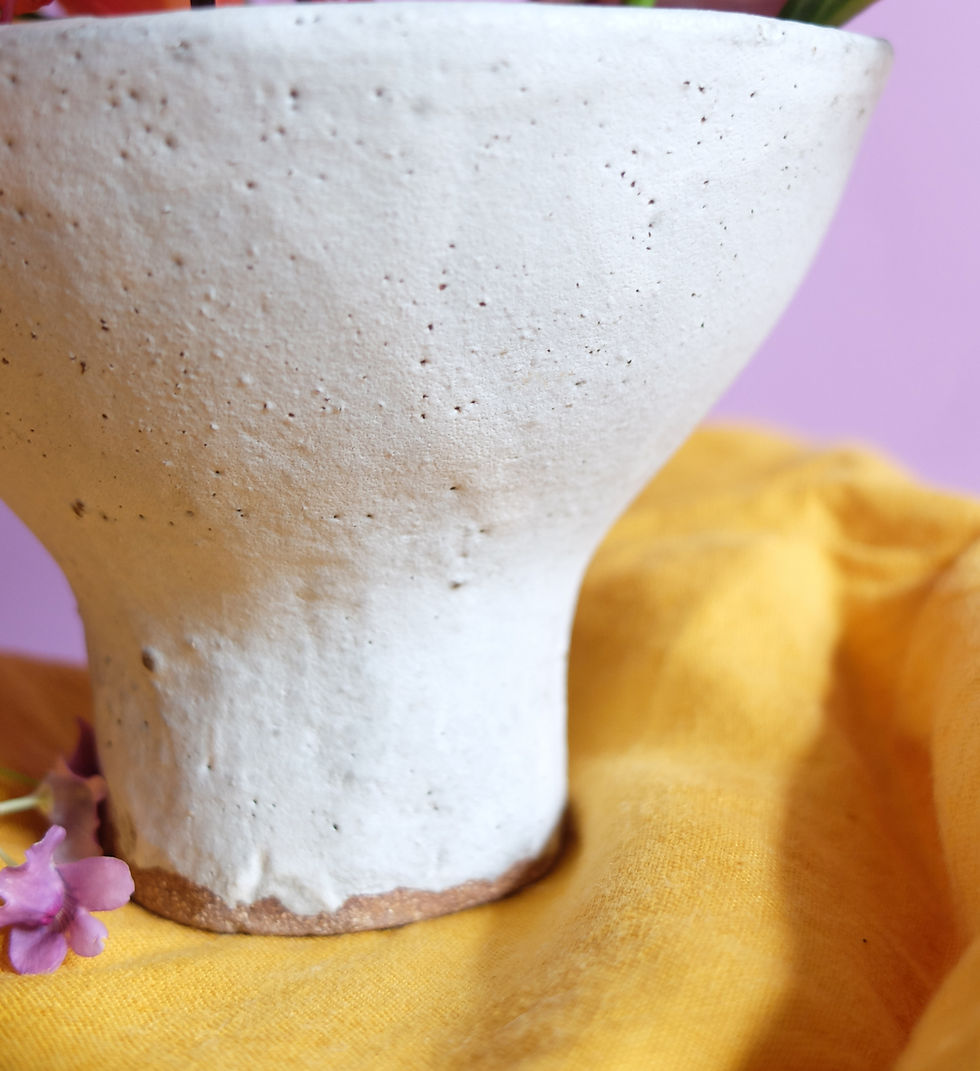Artist Portrait - Noe Kuremoto Ceramics
- Aurelien Farjon
- Oct 6, 2021
- 4 min read
Updated: Oct 14, 2021
Dear readers, for this month's edition I am delighted to introduce you to our very first "artist portrait" on the blog! Welcome to the playful world of Noe Kuremoto.
The Japanese ceramic artist creates sculptural yet functional works from her busy London studio. Her pieces mix child-like simplicity with contemporary sophistication, blending her background in Fine Art and design with her cultural heritage.
Keeping it functional
Having studied Fine Art at Central St Martin's, Noe has always made conceptual art objects but she eventually started to question whether she only wanted to talk to a discerning "Fine Art audience", or whether she wanted to speak to everyone who likes to see the beauty in this world. She eventually progressed to making more functional object.
"I think people are less intimidated by functional objects."
CLAY
Noe creates her pieces mixing stoneware clay with a lot of grog (or firesand) containing alumina, which adds that gritty rustic texture (called tooth). It reduces shrinkage and aids even drying.
"It’s durable clay and I need that strength to make sculptural objects".
Her white glaze seems to be have become her signature look, a cloudy matt white colour with tiny speckles, adding purity and calm to her work.
INVITE THE SPIRITS
A lot of Noe's pieces seem to be inspired by nature: branches, corals, pebbles, birds. She reveals that it is due to her sharing the traditional Japanese view that sprits are everywhere, especially in nature – for Noe the truth of our universe can be found in wilderness.
Her signature piece is a single flower vase - an ‘Ichirin Zashi’, which invites the sprits of nature into people’s homes in the simplest form possible. It is representative of her desire to make a deeper connection in a world that can often feel shallow.
“The single vase comes from my deep ocean of childhood memories."
On Inspiration
A project can start from a feeling buried within a childhood memory in Osaka, but sometimes it’s more tangible like a shape and story I want to share.
Kuremoto claims she does not source inspiration first. She thinks of a problem which already exists in the world and ponders over how she can offer a solution in her own tiny way.
"How can I bring a light to the world through my work?"
Usually this process becomes a story, which then turns into a collection's story line. For example the story behind her latest collection Dogu ladies started from her reflections over the birth of her own child, which then lead her to some of the most intriguing works from the Jomon period in Japan: clay figurines called Dogu (pronounced dough-goo). They were a talisman for safe childbirth.
"You can imagine how incredibly difficult giving birth would have been a few hundred years ago, right? Today I wish a safe child birth to contemporary women who are smart, career-driven and perhaps left their family-planning late (I did). Society glamourizes the role of career woman, we are blinded about the fact there is a life beyond the rat race. We are left feeling that children will get in the way of our ‘success’. My 30's disappeared so fast in the mist of 'business'. And one day I woke up, realized my eggs were running out! So these series is my contemporary interpretation of Dogu talismans and I dedicate it to all hard-working mothers-to-be"
LOOK AT THE MOON!
A general favourite is her iconic Moon Vase. She first created it for the Otsukimi (moon-viewing), Japanese festivals honouring the moon. Usually taking place in the mid-autumn, they start with celebrating the waxing moon then the full moon. On the evening of the full moon, it is traditional to gather in a place where the Moon can be seen clearly, decorate the scene with Japanese pampas grasses and serve white rice dumplings as offerings to the Moon in order to pray for an abundant harvest.
HIDDEN FIGURES! Noe confides: In Japan we also believe that there are rabbit families who live on the moon. They make mochi cake on the moon. So I created a hidden illustration of a rabbit family inside of each moon vase.
photo: Joseph Keys
Noe is a lover of the perfect imperfect, much like the ancestral Japanese Wabisabi astaetics , often described as one of appreciating beauty that is "imperfect, impermanent, and incomplete" in nature,
"Clay is just an extension of my life. I appreciate all imperfections in life."
"My ceramics are like a soothing daydreams that my hands, fire and clay turn into reality."
Photo: @cosmosandplums @lucia_svecova
Photo: @cosmosandplums @lucia_svecova
"I like making work intuitively
so anything unplanned
is usually the best work I produce."
For her latest collection Haniwa Warriors, Noe has opted for black stoneware, suiting fit for her modern take on these funerary objects said to protect monumental tombs in early Japan.
The picture below gives us a good sense of the rather large scale of these warriors.
"I always loved doodling as a little girl,
so playing with clay
to me is like drawing in the air."
Photo: @linajushk
FURTHER READINGS:
Download the full catalogue of her recent exhibition at Amelie Paris here
View her pieces "irl" in an upcoming group exhibition at MAH in London
Enjoy more of her collaborations with floral artist Cosmos & Plums here
CREDITS:
View and purchase all of Noe's work over on https://www.noekuremoto.com
#contemporaryceramics #ceramics #ceramicartist #ceramicblog #ceramicblogger #potter #pottery #homewares #contemporaryhomewares #noekuremoto #artist #artistreview #artiststory #artistinsight #exhibition #artistexhibition
















Comments